This Tokachi butadon is all about contrast. Crisp-edged pork belly slices, deep caramel soy glaze and fluffy rice working together harmoniously in one irresistible bowl. When it comes to donburi, it’s up there with the likes of gyudon and katsudon.
If you love that Japanese-style sweet-savory balance like teriyaki chicken, this recipe will not let you down. It hits that comforting, glossy glaze note perfectly.

Butadon
Recipe Snapshot
- What is it? A glossy, sweet-savory pork bowl coated in a caramelized soy glaze.
- Flavor profile: Sweet, Savory, Umami-deep
- Why you’ll love this recipe: Anyone who crave bold flavor but don’t want complex steps will appreciate how this dish delivers a deep sweet-savory payoff with weeknight-level effort.
- Must-haves: Japanese soy sauce, Pork belly (or shoulder), Sugar (Turbinado or light brown)
- Skill Level: Easy
Summarize & Save this content on:
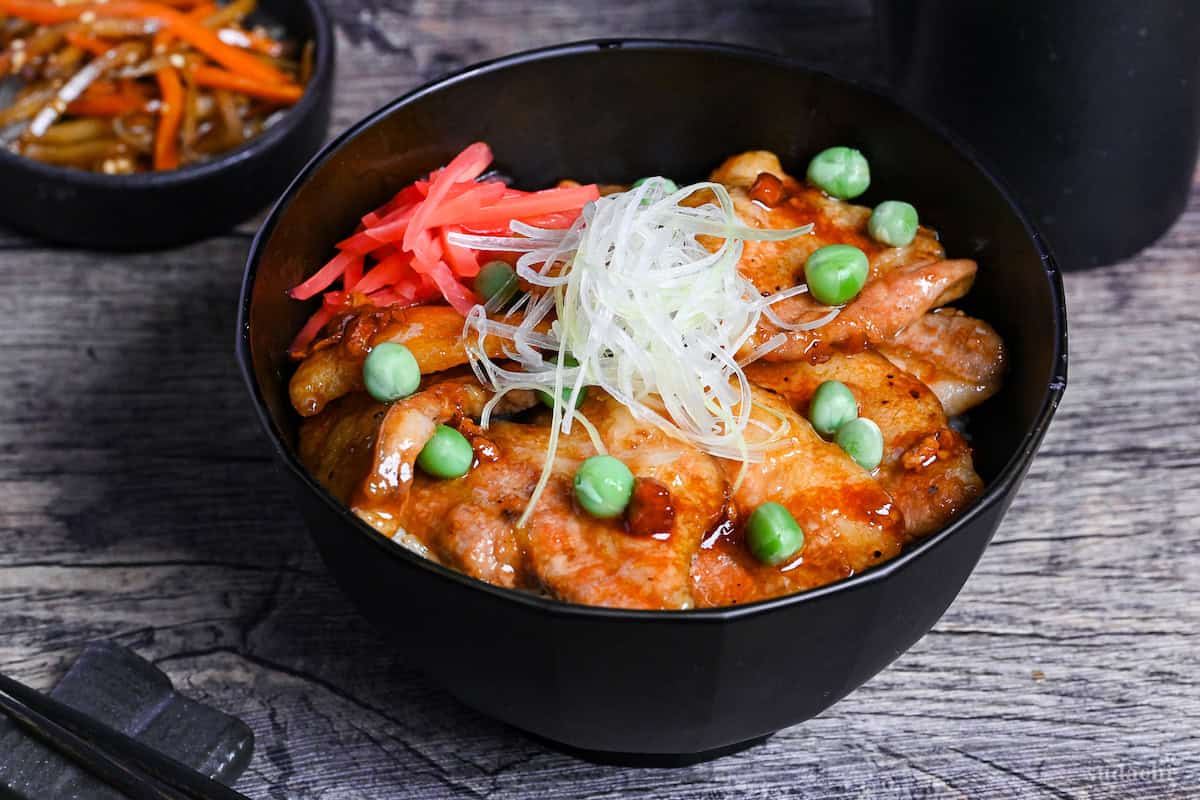
What is Butadon?
Butadon (豚丼) is a comforting pork-and-rice bowl from Tokachi in Hokkaido. Think tender slices of pork lightly crisped in a glossy caramel soy sauce, and totally doable on a weeknight. The flavor is more or less similar to teriyaki, but even deeper and richer.
Hokkaido’s food culture is full of standout dishes like miso ramen, jingiskan, and ishikari nabe. Butadon is definitely one of them, but weeknight-friendly at the same time.
Unlike dishes that require ultra-thin pork slices, Butadon is wonderfully forgiving. A regular slab of pork belly or shoulder from your regular market works perfectly. You’ll get that restaurant-style shine with very little fuss with one trick.
Japanese Pork Bowl Ingredients
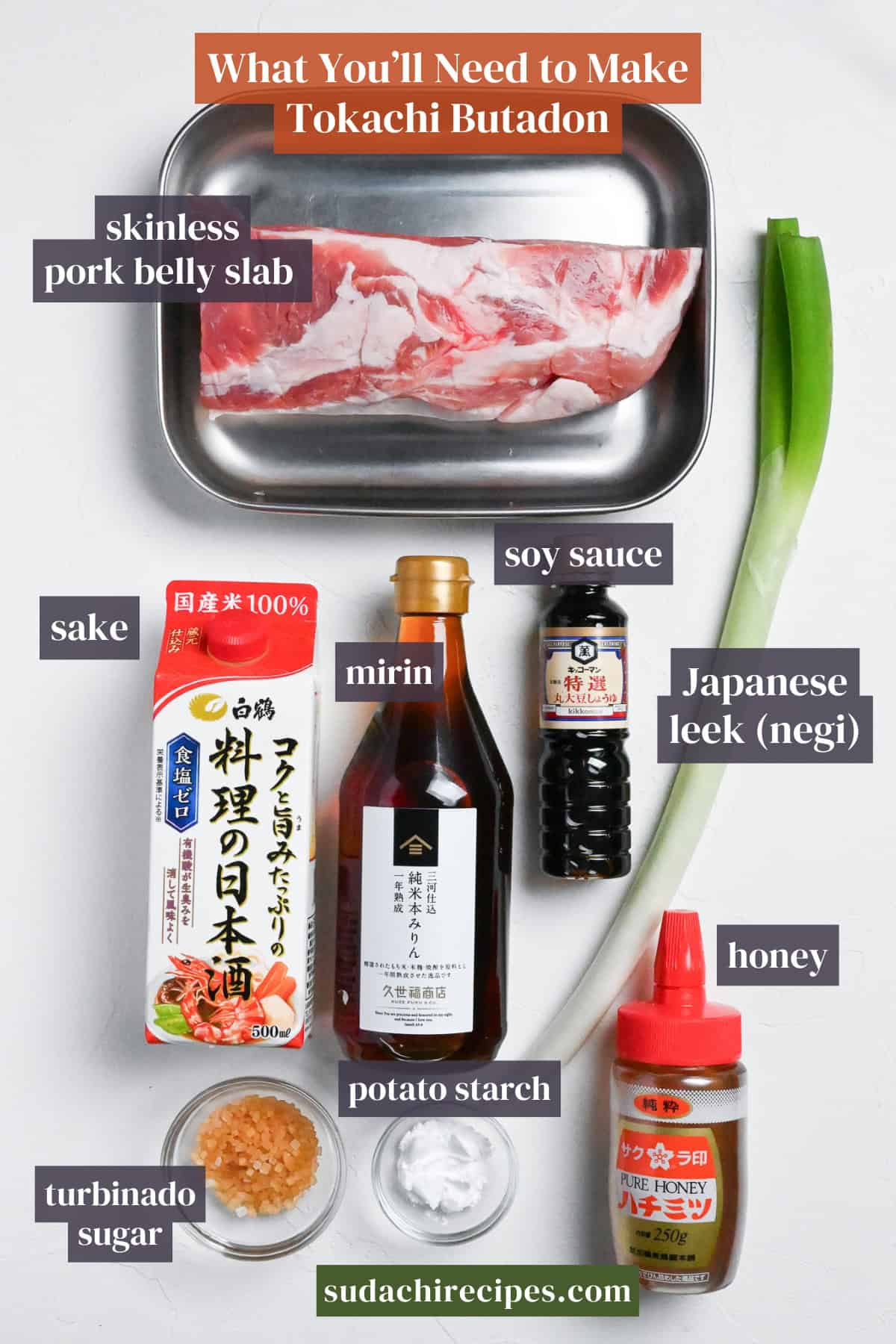
- Pork belly or pork shoulder: Pork belly gives you that melt-in-your-mouth richness and stays tender even if you slightly overcook it. If you can’t find pork belly, pork shoulder works. I will explain the alternatives more in the next section.
- Sugar (turbinado, aka “Sugar in the Raw”): In this recipe, I use a clever trick. You’ll caramelize the sugar first to more or less mimic that deep, slightly smoky flavor restaurants achieve with charcoal grills. Turbinado sugar (the coarse tan crystals) caramelizes beautifully, but regular light brown sugar works just as well
- Japanese soy sauce (koikuchi shoyu): This is your non-negotiable ingredient. The backbone of that signature sweet-savory glaze. Look for bottles labeled “koikuchi shoyu” or simply “Japanese soy sauce” at any Asian grocery store, or grab Kikkoman at your regular supermarket (it’s the real deal).
Pork Cut Alternatives
Traditionally, Tokachi-style butadon uses pork loin or pork belly, both readily available and budget-friendly options.
| Cut | Characteristics | Final Result |
|---|---|---|
| Pork Loin | • Leanest option • Can dry out easily • Requires careful cooking | Clean flavor, meat-forward taste More challenging to master |
| Pork Belly | • Thick fat layer for richness • Very forgiving to cook • Sauce adheres well | Rich, indulgent finish |
| Pork Shoulder | • Well-marbled with fat • Forgiving and easy to work with • Stays juicy | Balanced richness Beginner-friendly |
| Pork Butt | • Heavily marbled • Very forgiving cut • Great flavor depth | Very rich and flavorful Nearly foolproof |
Although loin is the primary choice for restaurants, belly, shoulder, and butt are much more forgiving and harder to overcook, making them ideal for home cooking.
While it won’t be the same, you can use another protein as an alternative:
- Chicken Thigh: Can taste too light for butadon. Add garlic for the missing richness.
- Beef: Creates a completely different flavor profile. It will be a sukiyaki-like flavor. Also, the sauce doesn’t cling as well to the meat.
If I have to choose between these two, I would choose chicken thighs for sure! While these alternatives work, pork remains the optimal choice for authentic butadon flavor and texture.
How to Make My Butadon
If you prefer to watch the process in action, check out my YouTube video of this butadon recipe!
Slice the white part of a Japanese leek into hair-thin threads. This is “shiraganegi,” the garnish that adds both texture and a subtle onion perfume.
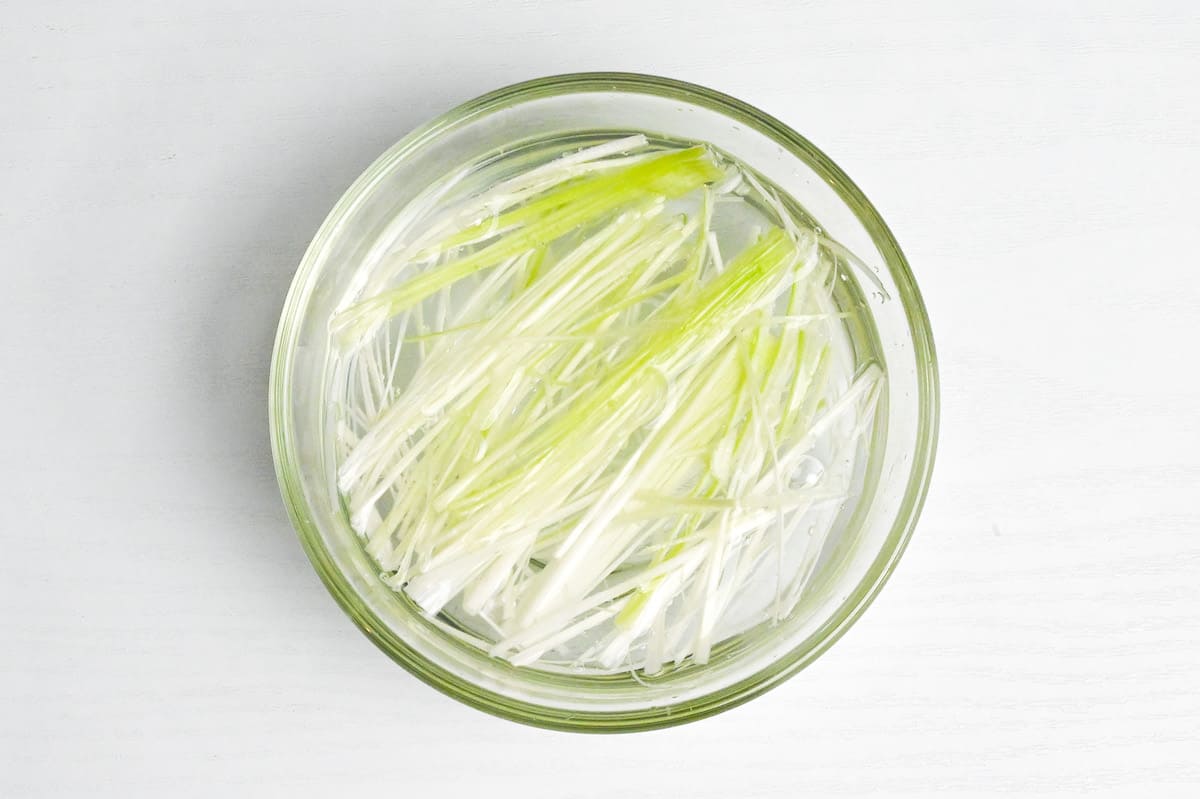
Soaking brings out the leek’s sharp sulfur notes while firming the strands. Drain after 10 minutes to keep that bite and flavor.
Trim the pork belly (or other cuts) into slices that are about 4-5 mm (a little less than ¼-inch) thick. If you want to make it easily with pre-cut meat, I recommend getting pork labeled “for samgyeopsal (Korean pork BBQ)” at an Asian supermarket.
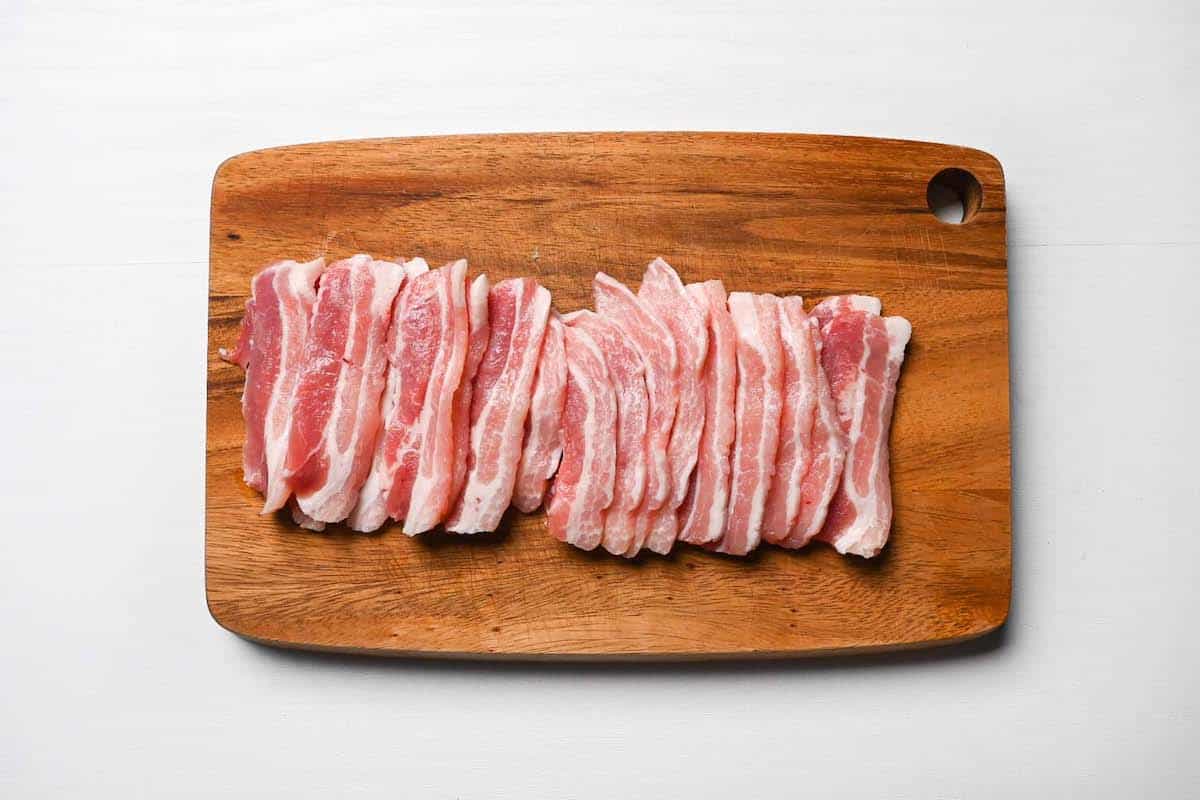
Pat the slices dry, then sprinkle a bit of salt. Let them sit for about 5 minutes.
Stir one-third of the measured water into the turbinado sugar in a small, light-colored saucepan. Seeing the color change is key.

Warm over medium heat, swirling (never stirring) until the syrup turns the shade of amber. Quickly add the remaining water; it will hiss, so stand back.
At 160 °C (320 °F), sucrose breaks into caramelization products that smell like toasted nuts and butter. Stop at deep amber for complexity without burnt bitterness.

Reduce the heat, pour in soy sauce, sake, mirin, and honey, and simmer just until slightly thickened to a runny syrup-like consistency. Be careful not to let it get too thick.

Remove the pan from the heat and set aside for later.

Put the pork in a bowl, add pepper and potato starch, and mix to make a very thin coating. This will help the glaze coat evenly later.

Heat a large frying pan on medium-high, and once hot, add a drizzle of oil. Place the pork flat in the pan, and try to keep it to one layer.

Let the first side brown undisturbed. This is where flavor happens, then flip.

Immediately after flipping the pork, wipe away any excess rendered fat using kitchen paper.
Pork fat contains flavorful fatty acids like oleic acid, and leaving a moderate amount enhances the richness. However, too much fat can make the dish overly rich and make the sauce oily, so wipe off any excess fat to achieve a good balance.

Pour the caramel sauce around the pan.

Keep the heat at medium; you want the glaze to thicken just enough to cling, not scorch. Move the pork around the pan and flip occasionally until the sauce has thickened and evenly coated both sides.

Remove the pan from the heat and move on to assembling the dish. If you want to really go for that charcoal flavor, you can even blowtorch the pork on a torch-safe surface.
Scoop hot Japanese short-grain rice into serving bowls.
Drape the glossy pork slices on top, and crown with drained shiraganegi, a handful of bright-green peas or edamame, and some benishoga (optional).

If you’re feeling adventurous, squeeze in a bit of fresh lemon juice for a quick burst of freshness, dust with shichimi for a spicy kick, or slide on a soft-set egg and let the yolk mingle with the glaze.
Enjoy!
Jump to Full Recipe Measurements
Essential Tips & Tricks
- Use a pan big enough for one layer of pork with no overlapping, or fry in batches.
- Swirl, don’t stir, the sugar syrup and stop when it turns deep amber; darker than that means bitter.
- Chill the shredded leek in ice water for 10 minutes, then drain.
- Taste before serving and brighten with a squeeze of lemon if the sweetness feels heavy.
With these simple tips in mind, you’re set for success every time you make butadon.
Storage Guide
Fridge: Cooked pork with glaze in airtight container, 1-2 days. Store rice separately. The glaze will thicken and pork fat will solidify when cold.
Freezer: Not recommended.
Reheating: Add 1-2 teaspoons of water to the pork and glaze in a skillet over medium-low heat, stirring gently until the sauce loosens and becomes glossy again.
What to Serve With This Recipe
Butadon FAQ
Butadon originates from a region in Hokkaido called “Tokachi” (十勝). It’s well known for its high-quality pork and locally grown rice. When served together, it creates the most comforting rice bowl dish. Pig farming started in the early 1900s in the Tokachi region, and the pork was simply steeped in sugar and soy sauce and then cooked on a grill, creating a charred effect. Although grilling is preferred, my recipe only requires a frying pan, and I can promise you it’s still delicious. Butadon is now a regional dish that Tokachi is extremely proud of; if you ever get a chance to go there, you should definitely try it out!
Keep the pan moving so the glaze doesn’t pool and scorch on one spot. If it does taste bitter, a splash of mirin can mellow the flavor, but burnt aromas won’t disappear. Prevention is key.
Professional kitchens rely on charcoal grills and “aged” sauce continuously topped up. At home, you can mimic the effect by briefly torching the finished pork or adding a literal drop or two of liquid smoke if you wanna get adventurous.

More Japanese Donburi Recipes
- Katsudon (Crispy pork cutlet and steamed egg)
- Gyudon (Thinly sliced beef and onions simmered in a dashi sauce)
- Oyakodon (Delicious pan-fried chicken and steamed egg)
- Tanindon (Japanese Pork and Egg Rice Bowl)
If you love one-bowl meals, this roundup of Japanese rice bowl dishes will give you plenty of inspiration for quick weeknight dinners.
Did You Try This Recipe?
I would love to hear your thoughts!
💬 Leave a review and ⭐️ rating in the comments below. 📷 I also love to see your photos – submit them here!
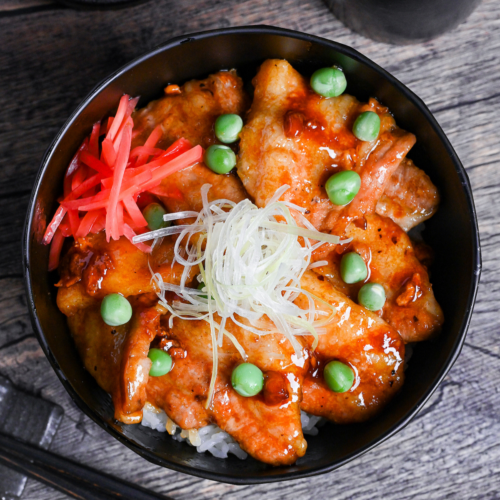
Butadon (Hokkaido Style Pork Rice Bowl)
Ingredients
- 10 cm Japanese leek (naganegi) white part
- 1 tbsp turbinado sugar or light brown sugar
- 4 tbsp water
- 1 ½ tbsp Japanese soy sauce (koikuchi shoyu)
- 1 tsp sake
- 1 tsp mirin
- 1 tsp honey
- 300 g slab skinless pork belly or pork shoulder/butt
- 1 pinch salt and pepper
- 1 tsp potato starch or cornstarch, for light dusting
- 2 tsp cooking oil canola, rice bran, etc.
- 2 portions cooked Japanese short-grain rice
- green peas or edamame (precooked)
- red pickled ginger (benishoga) optional
My recommended brands of ingredients and seasonings can be found in my Japanese pantry guide.
Can’t find certain Japanese ingredients? See my substitution guide here.
Instructions
- Cut 10 cm Japanese leek (naganegi) (white part) horizontally to the core and peel off outer layers.

- Press the layers flat on a cutting board and cut thinly along the grain to make strings.

- Place the strings of leek in a bowl of ice cold water for 10 minutes, then drain.

- Measure out 4 tbsp water. Take a saucepan and add 1 tbsp turbinado sugar and about 1/3 of the water. Place the pan on the stove and heat on medium, swirl the pan around occasionally for even heating (avoid mixing).

- Once it turns golden, add the rest of the water and swirl it around. (Be careful of splashing, protect your skin with oven mitts and long sleeves.)

- Reduce the heat to medium-low and add the 1 ½ tbsp Japanese soy sauce (koikuchi shoyu), 1 tsp sake, 1 tsp mirin and 1 tsp honey. Continue to heat until it reaches a thin syrup-like consistency, then turn off the heat and set aside for later.

- Cut 300 g slab skinless pork belly into thick slices about 4-5mm thick (a little less than 1/4 inch).

- Place it in a bowl and add 1 pinch salt and pepper and 1 tsp potato starch. Mix until evenly covered.

- Heat a large frying pan on medium-high, and add 2 tsp cooking oil. Once hot, arrange the pork slices in a single layer without overlapping, and fry until golden brown on one side.

- Flip the pork slices and use a piece of kitchen paper to wipe the excess rendered fat out of the pan.

- Pour the sauce all over the pork slices and move them around in the caramel sauce to coat. Continue to heat until thickened and clings to the surface of the pork, then remove from the heat.

- Dish up 2 portions cooked Japanese short-grain rice in serving bowls and arrange the pork slices on top. Garnish with the shiraganegi, green peas (or edamame) and red pickled ginger (benishoga). Enjoy!







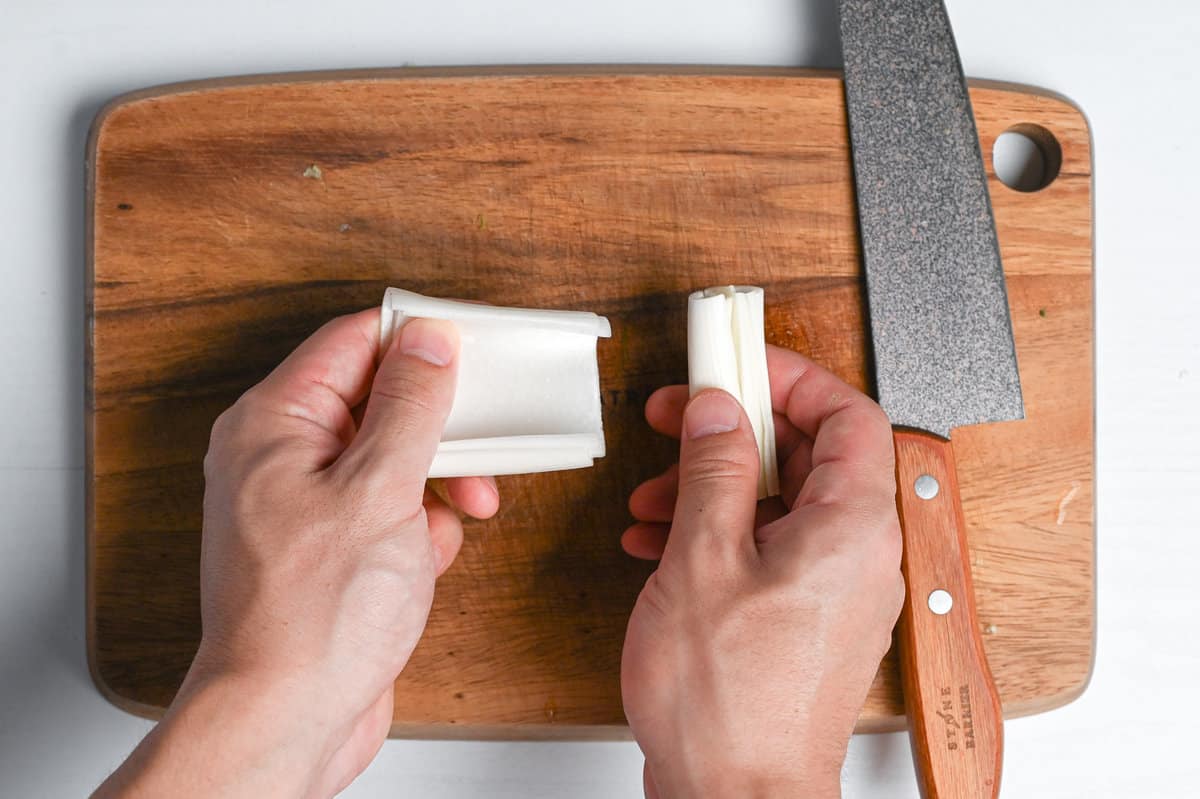
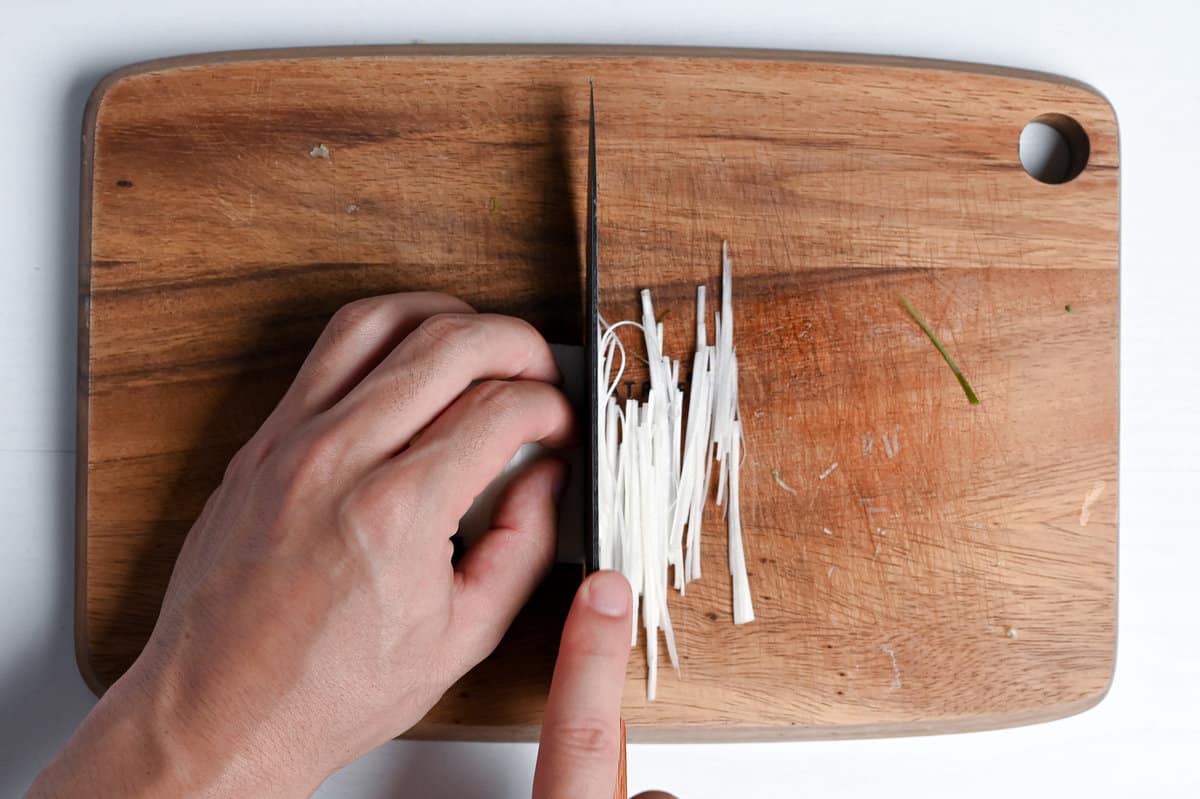

Leave a rating and a comment